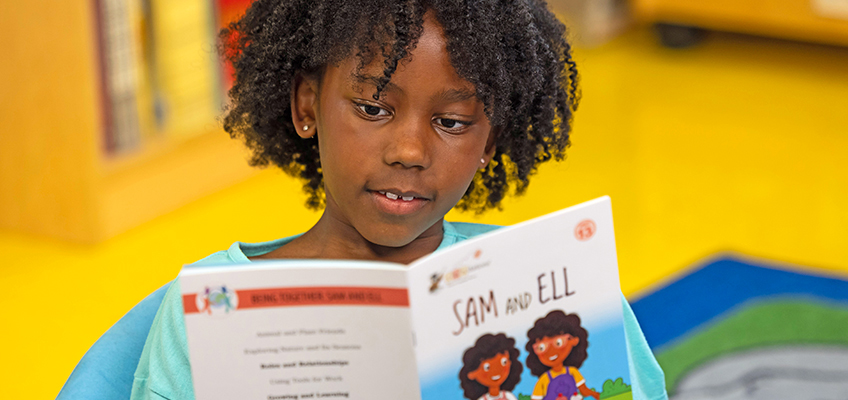
The ultimate goal of reading instruction, and any program that follows a Structured Literacy approach to instruction, is to help students transfer foundational literacy skills into being able to read and comprehend a book off the shelf. Decodable texts play a crucial role in the process of learning to read, enabling emerging readers to progress toward reading rich, grade-level texts with confidence.
Decodable texts are carefully controlled and aligned with the scope and sequence of a word study curriculum. In a decodable text, most of the words should contain taught phonics elements and high-frequency or irregular words that have already been introduced. While the optimal percentage of pre-taught words or phonics elements is unclear (Cheatham & Allor, 2012; Mesmer, 2001; Pugh et al., 2023), it is sensible to consider that the higher percentages provide more practice opportunities. A text with 95% or more decodability that aligns with a program’s scope and sequence allows students to have repeated practice reading words in connected text. These texts are particularly beneficial for students still developing word-level skills, offering ample practice applying learned phonics patterns.
Fundations® Readers are effective decodable texts. Designed for K-2 students, these Readers align with Fundations, a program that follows a Structured Literacy approach to instruction. The Readers build skills cumulatively by targeting newly taught and previously learned phonics concepts—helping students develop automaticity with specific word structures. The Fundations Readers have a decodability range of 95% to 100% and include both narrative and informational text.
Decodable texts support the development of word recognition skills in three key areas: accuracy, automaticity, and prosody. Accuracy involves correctly pronouncing words, laying the foundation for fluency. Automaticity means reading words quickly and effortlessly, while prosody refers to reading connected text with sufficient expression, natural phrasing, and rhythm, and tone, avoiding unnatural, choppy, or robotic-sounding reading.
Fluency bridges word recognition and comprehension. It involves reading accurately, at an appropriate pace, and with suitable expression—enabling deeper understanding and boosting motivation to read. Students with emerging decoding skills need regular practice reading connected text to build fluency. As students become fluent readers, the cognitive demands shift from decoding to comprehension.
High-quality decodable texts also allow teachers to focus on vocabulary and comprehension while building fluency. Teachers can model how good readers create a coherent mental model—forming a vivid and integrated understanding of the text’s events or facts. Students can learn to self-monitor by pausing, rereading, and checking vocabulary when needed. This process supports the “Read, Replay, and Retell” strategy—a lifelong tool for comprehension and organizing thoughts about any text.
Teachers should incorporate decodable texts during the small-group portion of the literacy block, using assessment data and daily observations to form targeted instructional groups. These groups may include: a facilitated support group for students needing teacher-led practice to improve word-reading accuracy; a monitor and practice group for students nearing mastery who benefit from extra practice to build automaticity and fluency; and an extend-and-explore group for students demonstrating mastery, allowing them to work independently on writing, research, vocabulary building, speaking, and listening activities. Students may also benefit from decodable texts during independent reading time as they gain confidence in their reading development.
Using decodable texts effectively involves multiple readings with varying levels of teacher support. The first read of a decodable text should focus on ensuring that students understand the meanings of most words and can follow the story or informational text. Teachers may read aloud to model fluent reading or have students read in pairs.
Subsequent readings should involve multiple interactions with the text through a variety of activities depending on students’ needs and skill levels. These could include echo reading, choral reading, paired reading, or independent reading, but all students should read the decodable text orally at least once to build fluency and comprehension.
Decodable texts are essential tools that help bridge foundational literacy skills to independent reading. As reading proficiency and automaticity increase, the need for decodable texts diminishes, transitioning students toward reading connected, complex texts. The early development of skilled reading fosters the development of comprehension, and as students develop foundational skills, they may spend more time reading, thus helping them become better readers (van Bergen et al., 2020). Through intentional design, guided practice, and thoughtful classroom integration, decodable texts pave the way for students to become confident, capable readers ready to explore the world of books.
Cheatham, J. P., & Allor, J. H. (2012). The influence of decodability in early reading text on reading achievement: A review of the evidence. Reading and Writing: An Interdisciplinary Journal, 25(9), 2223–2246. https://doi.org/10.1007/s11145-011-9355-2
Mesmer, H. A. (2001). Decodable text: A review of what we know. Reading Research & Instruction, 40(2), 121–141.
Pugh, A., Kearns, D. M., & Hiebert, E. H. (2023). Text types and their relation to efficacy in beginning reading interventions. Reading Research Quarterly, 58(4), 710–732. https://doi.org/10.1002/rrq.513
van Bergen, E., Vasalampi, K., & Torppa, M. (2021). How are practice and performance related? Development of reading from age 5 to 15. Reading Research Quarterly, 56(3), 415–434. https://doi.org/10.1002/rrq.309